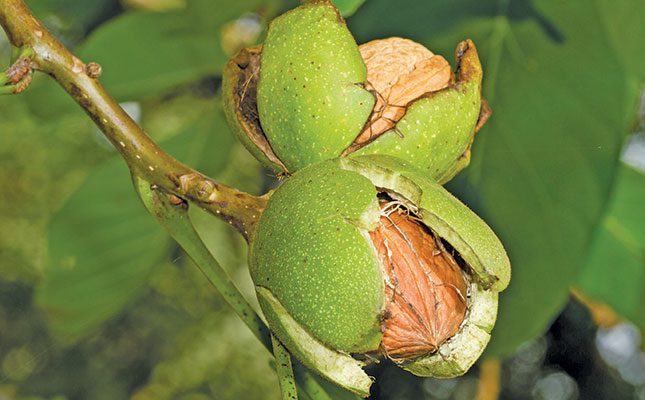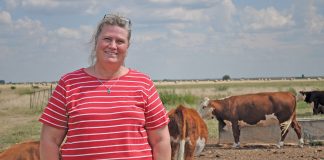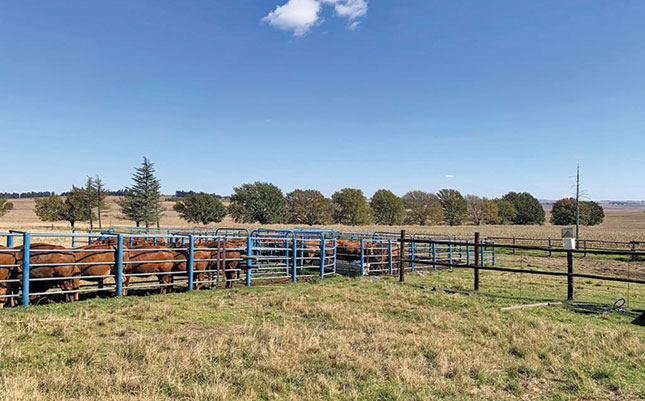
Photo: Supplied
The 10-year wait for a return on investment is enough to put most investors off any opportunity.
Recognising the potential of the nut industry to create jobs and boost rural economies, the Industrial Development Corporation (IDC) decided to invest in walnut production, establishing the first orchard in South Africa in Aliwal North in the Free State in 1998.
But the undertaking soon proved to be bigger than what they could handle and the farm was put up for sale four years ago. Investment banker Chris Edwards was then coaxed by his business partner to consider switching his suit for overalls.
“He kept saying there are big opportunities in agriculture, and walnuts specifically, but I didn’t want to wait seven years for an income.”
Counting in the farm’s favour is the counter-seasonality of Southern Hemisphere production. About 90% of walnuts are grown in the Northern Hemisphere, with Chile and Australia making up most of the other 10%.
This provides a good opportunity to gain higher prices when there is low global supply.
Edwards took the plunge and Rotondo Walnuts is today the largest walnut farm in Africa. They also hold over 90% of South Africa’s market share of locally grown nuts and their quality parameter is in the top 5% globally.
Walnut farming does not come without its challenges. Edwards notes that since walnut farmers are only now starting to emerge in South Africa, information on local production practices was absent when they first started.
Even today, there is still much to uncover. In the meantime, production practices from the local pecan industry, and the walnut industry in California, US, needed to be adapted to local walnut production.
Then there is the issue of profitability, since most nut prices fell during COVID-19 and the economic shocks that followed.
“Prices were through the floor in 2021, with production costs in the US averaging US$6,50/kg (about R123) while farmers were only getting paid US$5/kg (R95). Consequently, Californian farmers started pulling out trees and halting irrigation on trees below five years of age,” laments Edwards.
Saving grace
South Africa’s saving grace was however that production costs are around 20% cheaper than in the US, meaning that the price offered is still feasible.
Rotondo is also able to sell nuts into the South African market at the same price at which US nuts land here, but without having to factor in shipping costs, the local walnuts are more profitable.
Walnut consumption is growing locally and globally. Rotondo’s intention was to export at least 50% of its crop, but with growing local demand – around 20% a year – most nuts don’t leave the country.
There is still much room for growth since South Africa consumes only 5% of the total world average per capita consumption.
Edwards believes that the better-tasting South African nuts compared to imported varieties will further drive local demand.
“For the first time, South Africans have been introduced to high-class, quality walnuts, and every time you open a magazine there is an article punting the health benefits of walnuts.”
He adds that this growth is not just a fad, but a trend that’s here to stay.
“Tree nut consumption is growing at a rate faster than overall food consumption globally, because it is a health food. We are seeing the biggest walnut growth per capita in India, which is also where the highest population growth is concentrated.
Turkey, Iran and Europe are also big consumers. I believe prices will therefore bounce back and if you take a long-term view of the industry, you could have a success story on your hands.”
Feeding the need
Other farmers also recognise this potential, which has led to orchard establishment across South Africa where climatic conditions are favourable.
The fact that walnut trees are scarce in South Africa, and not easily propagated, made a strong business case for Rotondo to set up its own nursery. They now supply trees for their own farm and other farmers investing in production.
As resilient as walnut trees are when mature, their initial years are fraught with challenges, says Edwards. The process of harvesting new seeds, planting and grafting is particularly complicated for walnut trees.
Part of the challenge is to ensure farmers get only strong trees that will also bear a full yield in the years to come. The selection of the seeds at the right time, to select from the right trees, and the need to select healthy scion wood from mother-trees adds additional levels of complication.
Rotondo initially sourced rootstock from Chile and various varieties were planted during the first few years of research at the farm, when the IDC was still at the helm.
When Edwards took over, they eventually settled on a Spanish rootstock, largely regarded as the best in the world. They are also developing walnut trees grown from tissue culture in their greenhouse.
Optimal production
Walnut trees are hardy and can survive through a range of tough conditions. However they may not give good yields if not subjected to both hot temperatures in summer and cold in winter.
The hardy nature of the trees means Edwards replaces only 0,2% a year. The main cause for them not making is waterlogging because drainage hasn’t been good in that part of the orchard.
Water is big consideration. Rotondo irrigates using water from the Orange River, since normal rainfall patterns in the area are insufficient to meet the volume and timing needs for the trees.
Micro-irrigation is used, with an hourly delivery of 2,4mm. Walnut trees require roughly 1 000mm of irrigation (rain included) throughout the season. This is however dependent on the transpiration rate of a specific climatic zone.
Rotondo therefore schedules irrigation based on soil moisture probes, stem-water potential measured by pressure chamber, replacement of evapotranspiration and visual inspection of soil through soil augers or profile holes.
For optimal nutrition, leaf and soil analysis is done annually to determine the nutritional status of orchard groups. This is combined with data on production per hectare and vigour to finetune the total demand.
Fertiliser is applied at four phenological stages throughout the season: bud break till end of fruit set in September and October, rapid fruit growth in November and December, shell hardening and kernel filling in December and January, and pre-harvest and reserve build-up in February and March. Supplemental foliar nutrition is applied, especially zinc and potassium.
Pest and disease challenges abound, which is addressed through a comprehensive integrated pest management programme. This includes scouting and the determination of thresholds, as well as an understanding of the life cycles of pests and diseases and their interaction with the environment.
The biggest challenge presents in the wet season and includes fungal and bacterial diseases, soilborne diseases like crown gall and Phytophthora. Nematodes can also impact vigour and tree health. Insect pests include codling moth, ollworm, scale insects and red spider mite.
Long-term considerations
Walnuts are a long-term investment but also offer long-term benefits. The first harvest arrives in year five and by year 10 there is full production.
Trees can be in full production for about 60 years, whereafter it will slowly reduce at a rate of about 2%/year. One can therefore expect a reasonable yield for 70 to 80 years.
Rotondo focuses mostly on three varieties: Chandler, Serr, and Howard, planted across 490ha. This equates to 74 000 trees. Mature trees will yield between 5t/ha to 7t/ha, depending on tree spacing and variety.
The latter two aspects should therefor be carefully considered when establishing an orchard. In Rotondo’s case, much of the farm was already established when Edwards took over and the wider spacing and older varieties give them their biggest headaches.
He says the ideal spacing is about 8mx6m. “This will provide a good concentration of tree numbers per hectare. It will also prevent the trees from getting too big, which makes management more difficult.”
Soil preparation before planting is crucial to improve the orchard’s performance in yield, tree health and vigorous growth over the years. Edwards explains that the goal of soil preparation is to break up and loosen any compacted soil, as walnut trees will not grow well with restrictive layers in the sub-soil.
Good drainage is vital; he advises increasing soil organic matter and soil biology as much as possible before planting, so that it can be incorporated into deeper soil layers.
Getting to market
Harvesting practices differ greatly depending on the climate. At Rotondo the wet harvest season, starts in early March and runs through to the middle of May, is a challenge.
Edwards explains that for mechanical harvesting, the orchard bed needs to be dry. “Since other big producers like the US, Chile and Australia harvest in dry months, we were unable to learn from them, and had to develop our own system for harvesting and drying.”
Blowers run through the orchard to move the walnuts out of the rows. Sweepers then collect the nuts into harvestable rows, where the harvesting machines collect them and deposit them into trailers.
Rotondo has the only cracking facility in Africa and other farmers need to export their produce in-shell. The facility required significant investment and the aim was to only meet the processing needs of Rotondo’s nuts.
The walnuts go through a multi-stage process to remove the shell and all unwanted pathogens and bacteria. The nuts need to be dried and Rotondo uses a furnace burner, fed with walnut shells, to minimise its use of coal.
The nuts are then cracked and sorted by mechanical e-sorters that were made in Switzerland, for size and colour. Selected walnuts are sent through a manual inspection under bright lights by teams of highly skilled operators.
Lastly, the nuts are sent through a UV sterilisation process before being vacuum-packed with nitrogen flushing. Once packed and sealed, the final cartons are run through metal detectors.
About 30 other, smaller farms are scattered around South Africa. Chinese walnuts represent the biggest competition for Rotondo in the market.
These are however of an inferior quality and variety, producing bitter nuts in comparison to the creamier nuts produced by Rotondo.
Edwards explains that walnuts are evaluated predominantly by colour, lighter being better.
“Lighter walnut kernels are not better tasting but consumers shop firstly with their eyes. The second feature that consumers look for is size. A walnut kernel looks like a brain with two halves and if these can be processed without breaking those halves, prices are better.
“Only then do consumers look for taste. This is a shame as the walnuts our parents gave us 40 years ago were usually bitter and had allergenic after-effects. The walnuts produced in South Africa are recognised as being some of the very best in the world and are creamy.”
Nurturing the industry
As Rotondo has the bulk of the walnut expertise on the continent they believe they have a responsibility to nurture and grow the local industry. Edwards also notes that South Africa has millions of hectares of land that is well suited to walnut growing.
They have therefore launched the Walnut Institute of Southern Africa to supply new walnut farmers with trees and knowledge. Farmers will have the ability to travel to Rotondo, select their own trees from the nursery, and stay at the farm while learning how to plant and nurture the trees.
Training will focus on regenerative agriculture. “This is a long-term strategy to develop the knowledge and skills for the future of the Southern African walnut industry,” says Edwards.
Walnuts are underutilised in South Africa but looking at global trends, this is bound to change. Edwards believes South African walnuts are going to make a big name for themselves.
In the end, his scepticism was unfounded and he has an investment any banker would be happy to have.
Email [email protected].











